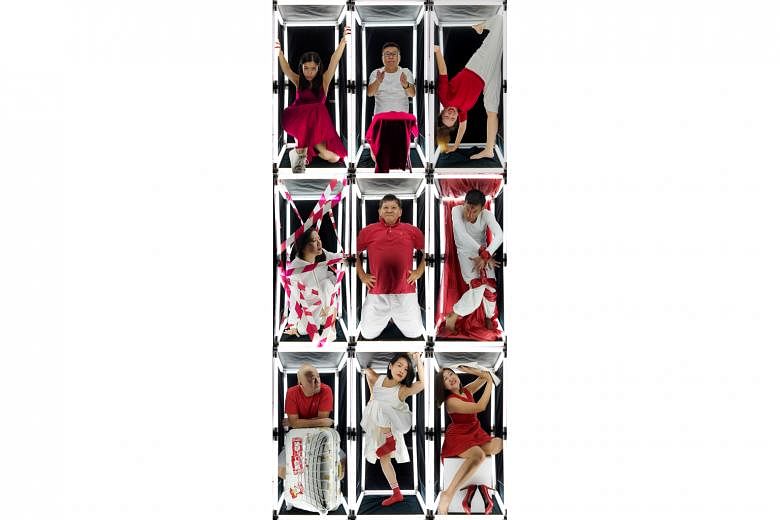The Substation closes for good in July. But before it does, its month-long SeptFest is gathering arts lovers for one final hurrah.
The festival runs till March 28 with performances and exhibitions at the independent arts centre in Armenian Street.
A three-hour finale event, The Last Chapter, will pay homage to the history and people of the 30-year-old institution.
Audience members will be guided through the building's nooks and crannies and encounter about 10 artists - such as stalwarts Johnny Ng and Kok Heng Leun and younger practitioners like Regina Toon - who will present dance, comedy and other works.
The poetic send-off will also involve a ceremonial raising and lowering of a curtain, says curator Lim Chin Huat somewhat cryptically, reluctant to give the surprise away.
"The Substation has been a place for budding artists and unconventional works. Many artists started there, moved out and became somebody - be it in dance, visual arts, music or film," says Lim, 51.
The Last Chapter will be a homecoming, a form of "closure and a way to re-establish our connection to The Substation," he adds. "I made an effort to get people from different eras and age groups to go back and see what would happen."
SeptFest kicked off its 22nd edition last Thursday with a performance by father-son duo Tang Da Wu and Zai Tang.
The festival, back after a six-year hiatus with the theme of In The Margins, had been slated to run last September but was postponed due to the pandemic.
Co-artistic director Raka Maitra, who is helming the festival, says: "The Substation has always been about the margins, a refuge for the fringe. I thought this was the right theme for the last festival at 45 Armenian Street."
Last week, the centre announced it would close permanently after the National Arts Council (NAC) takes back its building for renovations in July. The reason for closure was that it would not be able to return to the space in its entirety.
NAC had said The Substation could return as a co-tenant under the Framework for Arts Spaces scheme, but it would have to share the space with other arts groups.
NAC had offered interim premises and agreed to an additional $100,000 a year above the Major Company grant. But The Substation felt the funding offer was insufficient for it to continue its mission of supporting young artists.
Many members of the arts community lamented the loss of an arts incubator known for its experimental, multi-disciplinary spirit.
During a virtual townhall meeting organised by The Substation's board last Saturday, some of them challenged the decision, calling for the board to step aside and let others take over.
Lim, who has "mixed feelings" about the centre's closure, has fond memories of what was his "playground" in the 1990s.
"I would go there to meet friends, have discussions, participate in talks, exhibitions, workshops, the Sunday Market, outdoor performances. I expected a new surprise every week," says the artist, who will do his last dance there at The Last Chapter.
"The Substation is where I did my first set design, first directing work, first performance and first full-length dance show. I used to be a visual artist. But when I went to The Substation, I was so impressed by the performing arts happening in front of me that I decided to do performing arts."
In 1991, he made his debut as set designer and a performer in Toy Factory Productions' experimental show, Redear, at The Substation.
Lighting designer Gabriel Chan, 37, who is also involved in The Last Chapter, describes the centre as a place that allowed young artists such as himself "to start somewhere, and to be able to try out their ideas and fail".
"It was really about the people," he adds, with a nod to collaborators such as Lim, who took a chance on him during a staging of multi-disciplinary show Fireball a decade ago. "I hope it will not become an abstract memory, like the National Theatre."
The theatre at the foot of Fort Canning Park was closed in 1984 after being declared structurally unsafe and was demolished two years later to make way for the construction of an expressway.
SeptFest also spotlights works by young artists such as Lina Yu, Subhas Nair and members of the group, from (a)basement theatre collective.
There are also two exhibitions.
Projek Orang Asli, which runs till Sunday, features Zai Kuning, Ronnie Bahari and Samri a/l Abdul Rahman. It is followed by the Migrant Workers Community Museum (March 18 to 28) by Alfian Sa'at, Vithya Subramaniam, Zulkhairi Zulkiflee and other collaborators.
Maitra, 51, who is the founder of contemporary dance company Chowk and was an associate artist at The Substation from 2007 to 2011, says the centre's impending closure is "heartbreaking".
"I hope these young artists we have supported, who have developed works here, find their place somewhere and take the spirit of The Substation wherever they go," she adds.
"We are supposed to be this modern city state. We can afford The Substation. But we need to ask ourselves whether we want to afford The Substation and if we want it to survive. Each of us has to take responsibility, not just one person or one institute."
• SeptFest runs till March 28. Performances are sold out; entry to the exhibitions is free. Go to substation.org/septfest2021.


